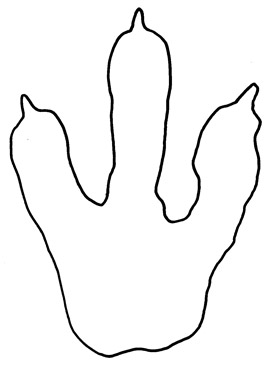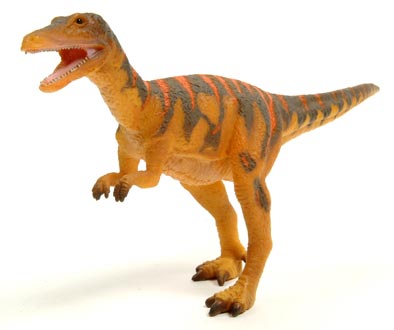Megalosaurus Footprints being Prepared for Display
Fossilised tracks made by a fierce Jurassic carnivore, Megalosaurus when Oxfordshire was part of a sub-tropical paradise have made a perilous journey to their new home, where they will go in display in the Autumn.
The fossil footprints, measuring 50 cm across have been transported from the temporary storage site to the Oxfordshire Museum, where they will feature in a permanent exhibit dedicated to the dinosaur that is believed to have made these prints – a Megalosaurus.
Fossilised Footprints
The short trip to the museum marks the end of 10 years of excavation and planning after the trackway was first uncovered at a landfill site in Ardley, close to Bicester. The twenty-five mile trip from the storage site, where the fragile prints were prepared for their perilous journey, to the museum took five hours. Project Manager, Tom Freshwater, who works at the Oxfordshire Museum, commented:
“The prints weigh three tons each so the main challenge has been getting them into the garden, where they will be displayed. They had to be lifted very gently and smoothly because the rock is quite fragile and there are already cracks within the stone so we had to make sure that did not get worse.”
The fossil dinosaur footprints had been excavated in sections, of approximately 1 cubed metre, they were encased in plastic sheeting to protect them and set on steel plates to support the weight of the stone as the rocks made their journey. Having arrived safely at the Museum, each block was carefully winched over the Museum boundary fence into a specially prepared garden area. A great deal of care had to be taken as each block was lifted off the lorry, swung over the fence and placed in position. Despite their weight, the blocks are delicate and every precaution was taken to prevent any damage to the fossils.
A Jurassic Environment
The Museum plans to create a replica of the Jurassic environment and display the prints alongside a life-size model of a Megalosaurus. About 30 to 40 prints were originally discovered at Ardley Landfill and Recycling Centre, run by Viridor Waste Management, and those not been transferred have been preserved in situ. The prints are very important as meat-eating dinosaur tracks are exceptionally rare and these particular prints, believed to have been made by a megalosaur provide evidence of a change of speed of the animal. The spacing between the prints gets longer, indicating a bigger stride length and an increase in speed of the animal.
The exhibit is likely to be opened in October.
An Illustration of a Megalosaurus Footprint

Picture credit: Everything Dinosaur
Megalosaurus
Megalosaurus was the first dinosaur to be named and scientifically described, although the original specimen (known as the holotype), consists of a partial lower jaw, some teeth and a few scraps of fossil bone, it appears that this dinosaur was a fierce, general carnivore, perhaps the top predator around at the time. Although, scientists have improved their knowledge of European carnivorous dinosaurs (thanks to a number of new finds that have come to light over the last twenty years or so), the Megalosaurus genus has gained a bit of a reputation as a dumping ground for theropod miscellany. A number of carnivorous dinosaur fossils have been assigned to Megalosaurus, approximately 50 different genera have found themselves classified as Megalosaurus at one time or another. The exact taxonomic relationship between these various carnivorous dinosaurs remains uncertain but at least attempts have been made to re-define the characteristics of Megalosaurus and establish other genera for meat-eating dinosaur fossils.
Megalosaurus has been referred to as a “waste basket genus”, to read an article on this: Megalosaurus – a Dinosaur Waste Basket.
Megalosaurus fossils are known from Europe and Africa, it is believed that they were capable of growing up to 9 metres in length, although the fossil trackway was made by a dinosaur estimated to be 7 metres long. Although it is impossible to precisely identify the exact species of dinosaur that made the prints, the tracks may have been made by a sub-adult animal. Estimates of the weight of megalosaurs vary, but the not fully grown animal that left its prints in the soft Jurassic mud all those millions of years ago, would have weighed more than 1,000 kilogrammes.
The Natural History museum created a scale model of Megalosaurus when they launched their dinosaur model collection a few years ago. They coloured this model in orange and grey stripes, although purely speculation these markings would have helped break up this fierce hunter’s outline keeping it hidden and help it ambush prey.
To view the Natural History Museum models: Natural History Museum Dinosaur Models.







Leave A Comment